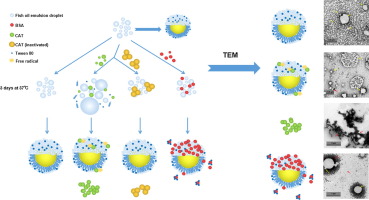Food Research International ( IF 7.0 ) Pub Date : 2020-03-18 , DOI: 10.1016/j.foodres.2020.109169 Lijing Ke 1 , Yang Xu 1 , Guanzhen Gao 1 , Huiqin Wang 1 , Zhaoshuo Yu 1 , Jianwu Zhou 1 , Pingfan Rao 1 , Qiang Wang 2 , Ji Yu 3

|
The physicochemical and oxidative stability of oil emulsion has been one of the major challenges in food industry. Factors influencing the emulsion stability have seemingly been exhaustedly elucidated, such as temperature, pH, salts, proteins, polysaccharides and digestive enzymes. Here we report the previously unrecognized influence of catalase on emulsion stability. Submicron oil-in-water fish oil emulsion was prepared by high speed homogenization in the presence of polysorbate 80. Influence of catalase on the emulsion’s stability was investigated in comparison with its deactivated version and bovine serum albumin (BSA) by visual examination, turbidity and DLS measurement and TEM observation. Catalase demulsified the emulsion instantly in a concentration-responsive manner at concentrations higher than 0.8 μmol/L, resulting a decreased turbidity, oil flocculation and precipitation of the enzyme itself. Neither BSA nor the thermally inactivated CAT caused demulsification at the same speed, indicating that CAT’s demulsification effect was attributed to its enzymatic activity rather than its general protein properties. The enlargement of oil-polysorbate droplets and precipitation of CAT were confirmed by both TEM and DLS. Furthermore, CAT’s demulsification effect was found irrelevant of the lipid oxidation. This insight into catalase’s influences on emulsion not only sheds lights on food processing and shelf-life, nutritional value and potential biological effects, but also presents an exciting challenge to elucidate the mechanism behind.
中文翻译:

过氧化氢酶使水包油鱼油-聚山梨酯乳液破乳并影响脂质氧化。
油乳剂的物理化学和氧化稳定性一直是食品工业的主要挑战之一。似乎已经彻底阐明了影响乳液稳定性的因素,例如温度,pH,盐,蛋白质,多糖和消化酶。在这里,我们报告了过氧化氢酶对乳液稳定性的先前无法识别的影响。通过在聚山梨酯80的存在下进行高速匀浆制备亚微米级水包油鱼油乳液。通过目测,过浊度和浊度,比较过氧化氢酶对其失活形式和牛血清白蛋白(BSA)的影响,研究了过氧化氢酶对乳液稳定性的影响。 DLS测量和TEM观察。过氧化氢酶以高于浓度的0.8μmol/ L的浓度响应方式立即使乳液破乳,从而降低了浊度,油脂本身会发生絮凝和沉淀。BSA和热灭活的CAT均不会以相同的速度引起破乳,这表明CAT的破乳作用是由于其酶活性而不是其一般的蛋白质性质。TEM和DLS均证实了油-聚山梨酯液滴的增大和CAT的沉淀。此外,发现CAT的破乳作用与脂质氧化无关。对过氧化氢酶对乳状液影响的见解不仅为食品加工和货架期,营养价值以及潜在的生物学效应提供了启示,而且为阐明其背后的机理提出了令人兴奋的挑战。表明CAT的破乳作用归因于其酶活性而不是其一般的蛋白质特性。TEM和DLS均证实了油-聚山梨酯液滴的增大和CAT的沉淀。此外,发现CAT的破乳作用与脂质氧化无关。对过氧化氢酶对乳状液影响的见解不仅为食品加工和货架期,营养价值以及潜在的生物学效应提供了启示,而且为阐明其背后的机理提出了令人兴奋的挑战。表明CAT的破乳作用归因于其酶活性而不是其一般的蛋白质特性。TEM和DLS均证实了油-聚山梨酯液滴的增大和CAT的沉淀。此外,发现CAT的破乳作用与脂质氧化无关。对过氧化氢酶对乳状液影响的见解不仅为食品加工和货架期,营养价值以及潜在的生物学效应提供了启示,而且为阐明其背后的机理提出了令人兴奋的挑战。发现CAT的破乳作用与脂质氧化无关。对过氧化氢酶对乳状液影响的见解不仅为食品加工和货架期,营养价值以及潜在的生物学效应提供了启示,而且为阐明其背后的机理提出了令人兴奋的挑战。发现CAT的破乳作用与脂质氧化无关。对过氧化氢酶对乳状液影响的见解不仅为食品加工和货架期,营养价值以及潜在的生物学效应提供了启示,而且为阐明其背后的机理提出了令人兴奋的挑战。









































 京公网安备 11010802027423号
京公网安备 11010802027423号